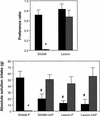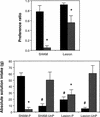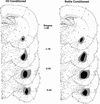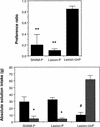Conditioning method dramatically alters the role of amygdala in taste aversion learning
- PMID: 10489263
- PMCID: PMC311265
Conditioning method dramatically alters the role of amygdala in taste aversion learning
Erratum in
- Learn Mem 1999 Jan-Feb;6(1):62
Abstract
Although an important role for the amygdala in taste aversion learning has been suggested by work in a number of laboratories, results have been inconsistent and interpretations varied. The present series of studies reevaluated the role of the amygdala in taste aversion learning by examining the extent to which conditioning methods, testing methods and lesioning methods, influence whether amygdala lesions dramatically affect conditioned taste aversion (CTA) learning. Results indicated that when animals are conditioned with an intraoral (I/O) taste presentation, lesions of amygdala eliminate evidence of conditioning whether animals are tested intraorally or with a two-bottle solution presentation. Dramatic effects of amygdala lesions on CTA learning were seen whether lesions were made electrolytically or using an excitotoxin. In contrast, when animals were conditioned using bottle presentation of the taste, electrolytic lesions attenuated CTAs but did not eliminate them, and excitotoxic lesions had no effect. These results are consistent with the hypothesis that neural structures critical for CTA learning may differ depending on the extent to which the method of conditioned stimulus delivery incorporates a response component.
Figures









Similar articles
-
Insular cortex lesions and taste aversion learning: effects of conditioning method and timing of lesion.Brain Res. 1999 Aug 28;839(2):323-30. doi: 10.1016/s0006-8993(99)01745-x. Brain Res. 1999. PMID: 10519056
-
Conditioning method determines patterns of c-fos expression following novel taste-illness pairing.Behav Brain Res. 2006 Apr 25;169(1):93-7. doi: 10.1016/j.bbr.2005.12.006. Epub 2006 Jan 19. Behav Brain Res. 2006. PMID: 16427145
-
Modulation of the magnitude of conditioned taste aversion in rats with excitotoxic lesions of the basolateral amygdala.Neurobiol Learn Mem. 2017 Jan;137:56-64. doi: 10.1016/j.nlm.2016.11.009. Epub 2016 Nov 12. Neurobiol Learn Mem. 2017. PMID: 27847246
-
Conditioned taste aversion and amygdala lesions in the rat: a critical review.Neurosci Biobehav Rev. 2005;29(7):1067-88. doi: 10.1016/j.neubiorev.2005.03.025. Neurosci Biobehav Rev. 2005. PMID: 15893375 Review.
-
Taste avoidance and taste aversion: evidence for two different processes.Learn Behav. 2003 May;31(2):165-72. doi: 10.3758/bf03195979. Learn Behav. 2003. PMID: 12882375 Review.
Cited by
-
Neural substrates for behaviorally conditioned immunosuppression in the rat.J Neurosci. 2005 Mar 2;25(9):2330-7. doi: 10.1523/JNEUROSCI.4230-04.2005. J Neurosci. 2005. PMID: 15745959 Free PMC article.
-
Hippocampal inactivation enhances taste learning.Learn Mem. 2005 Nov-Dec;12(6):579-86. doi: 10.1101/lm.32305. Learn Mem. 2005. PMID: 16322360 Free PMC article.
-
The Functional and Neurobiological Properties of Bad Taste.Physiol Rev. 2019 Jan 1;99(1):605-663. doi: 10.1152/physrev.00044.2017. Physiol Rev. 2019. PMID: 30475657 Free PMC article. Review.
-
Taste neophobia and c-Fos expression in the rat brain.Brain Res. 2012 Apr 11;1448:82-8. doi: 10.1016/j.brainres.2012.02.013. Epub 2012 Feb 12. Brain Res. 2012. PMID: 22405689 Free PMC article.
-
The Potential Role of Protein Kinase R as a Regulator of Age-Related Neurodegeneration.Front Aging Neurosci. 2021 Apr 28;13:638208. doi: 10.3389/fnagi.2021.638208. eCollection 2021. Front Aging Neurosci. 2021. PMID: 33994991 Free PMC article. Review.
References
-
- Bermudez-Rattoni F, McGaugh JL. Insular cortex and amygdala lesions differentially affect acquisition on inhibitory avoidance and conditioned taste aversion. Brain Res. 1991;549:165–170. - PubMed
-
- Bernstein IL. Flavor aversion. In: Getchell TV, Doty RL, Bartoshuk LM, Snow JB, editors. Smell and taste in health and disease. New York, NY: Raven Press; 1991. pp. 417–428.
-
- Braun JJ, Lasiter PS, Kiefer SW. The gustatory neocortex of the rat. Physiol Psychol. 1982;10:13–45.
-
- Chambers KC. A neural model of conditioned taste aversions. Annu Rev Neurosci. 1990;13:373–385. - PubMed
-
- Dunn LT, Everitt BJ. Double dissociations of the effects of amygdala and insular cortex lesions on conditioned taste aversion, passive avoidance, and neophobia in rat using the excitotoxin ibotenic acid. Behav Neurosci. 1988;102:3–23. - PubMed
Publication types
MeSH terms
Grants and funding
LinkOut - more resources
Full Text Sources
